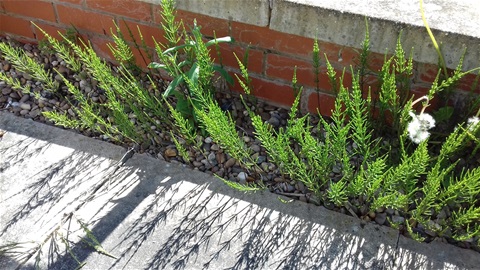Dealing with Horsetail (Mares Tail)
It is spring and as usual the thoughts of unlucky gardeners will turn to Horsetail (Equisetum arvense) also known as mares tail found on allotments, gardens and on waste ground and non-cropped areas. It has a thick, silica-rich outer layer and small needle-like leaves. And will now be appearing across the UK as light brown stems, 20-50cm (10-20in) before developing into 60cm (2ft) tall fir tree-like plants.
There is another variety of Marestail (Hippuris vulgaris) which is an aquatic weed found in ponds or slow-flowing streams. This advice applies to the variety found on allotments and gardens.
Horsetail can be a nuisance as it is difficult to eradicate and while repeated cutting will weaken the rhizomes it is usually ineffective as a mean of killing the deep-rooted plant. Control by digging can make the problem worse because each broken root fragment can develop into a new plant by itself. However, digging and carefully removing rhizomes can eventually be effective. Regularly removing the shoots and rhizomes as soon as they appear will weaken the plants, but total eradication requires determination over several years.
An alternative method of eradication involves adding dolomite lime to the soil around the horsetail to raise the soil pH. The lime is worked into the soil and watered thoroughly. Fertiliser is applied after two weeks. The process is repeated annually until the horsetail weeds are eradicated This can take up to five years
It can be controlled by successive applications of an appropriate weed killer such as Kurtail Evo.
On the more positive side. The
weed can be turned to good use by drowning and using the liquid as plant feed and the sludge as a booster to the compost bin. Drowning the plants to make horsetail tea liquid feed as part of the eradication programme can either
be in a lidded bucket or a water butt depending on the quantity. (My photos tend to be bucket based as we want to demonstrate the process rather than just eradicate the weed). Horsetail is high in silica and a when soaked to make a tea which, is said,
to coat the leaves of treated plants producing a fungicide and protect against blackspot, mildew, and mint rust.
Allotment site Committees, or groups in affected areas of allotments, might organise plot holders to spend a day on an
allotment wide horsetail harvest and drowning.
The plants need to be fully submerged under the water so are best put in a sack or an old vegetable net pinned down with a large stone or suspended in a submerged weighted bag. Regular stirring is recommended. The fermentation process can range from 10 days to 3 weeks, depending on the ambient temperature. During fermentation, the mixture will produce gas which will bubble on the surface. Once the bubbling has stopped it has finished bubbling the liquid can be strained and used.
Usually when I write about the eradication of this weed some readers will stress that it can be grown as a medical or cosmetic herb which is fine in a private garden but it should be remembered that the next occupant of an allotment plot, and possibly those cultivating adjacent plots, will inherited a problem of a very persistent weed. I advocate banning the deliberate cultivation of Horsetail on allotments.
Source further information
https://www.progreen.co.uk/content/kill-horsetail-marestail/

Rachel Bartlett
Thank you for this helpful info. My problem is that mare’s tail is growing IN my wooden compost bin and my garden’s too small to move it. Can I make and use compost without spreading mare’s tail?